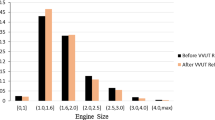Abstract
Electric vehicles (EVs) are one of the key solutions for global energy transition. As the renewable energy’s share in energy consumption continues to grow, replacing traditional fuel vehicles with EVs can effectively contribute to energy saving, carbon emission reduction, air pollution control and energy security. Most of the developments in the EV markets across the world occurred in the past decade, a time when China becomes the biggest market and the biggest driver of global EV markets. Along the development of China’s EV market, which can be divided into three stages, incentive policies, both direct and indirect ones, have played a critical role. The primary direct incentive policy—EV purchase subsidies—has directly impacted the development of global EV markets. Since the purchase subsidies are going to be phased out, indirect incentive policies including building charging infrastructure should be improved in the short term; and more new policies, such as the dual-credit policy, and the policy of inter-sectoral integration, should be adopted in the long term to boost EV development in China.
Access this chapter
Tax calculation will be finalised at checkout
Purchases are for personal use only
Similar content being viewed by others
Notes
- 1.
IRENA, Global Energy Transformation: A Roadmap to 2050 (Abu Dhabi: IRENA, 2019), 48.
- 2.
IPCC, “Chapter 2,” In Global Warming of 1.5°C (New York, IPCC, 2019), 142.
- 3.
Junling Liu et al., “Study on Mid- and Long-term Low Carbon Development Pathway for China’s Transport Sector,” Climate Change Research 14, no.5 (2018): 513–521.
- 4.
IEA, Global EV Outlook 2019 (Paris: IEA, 2019), 1.
- 5.
Yuefu **, Energy Conservation and Emission Reduction in China’s Transportation Sector: A Review of Statistics and Regulation (Bei**g: Energy Foundation, 2018), 24.
- 6.
IEA, Global EV Outlook 2019 (Paris: IEA, 2019), 7.
- 7.
Li **aohui, He Defang, and Peng Jie, “The Policy and Future Trend of Development of New Energy Vehicles in the Unites States,” Global Science, Technology and Economy Outlook, no.3 (2016): 63–71.
- 8.
Other national strategic emerging industries include energy conservation and environmental protection industry, new generation information technology industry, bio-industry, new energy industry, high-end equipment manufacturing industry, new material industry.
- 9.
The digital creative industry was added to national strategic emerging industries since 2017.—Trans.
- 10.
Whether a policy is a direct or indirect incentive depends on the angle from which we look at the policy and the industrial process in which it is implemented. For example, from the perspective of boosting EV technologies and industrial development, preferential policies that support R&D, investment and land use are direct incentives while EV purchase subsidy is an indirect incentive policy.
- 11.
Qian **g**g et al., Low Carbon Development and Early Emissions Peaking in Chinese Cities: Case Studies (2018) (Bei**g: Energy Foundation, 2018), 23.
- 12.
Tan Ruipeng, Tang Di, and Lin Boqiang, “Policy Impact of New Energy Vehicles Promotion on Air Quality in Chinese Cities,” Energy Policy 118 (July 2018): 33–40.
- 13.
IRENA, Innovation Outlook: Smart Charging for Electric Vehicles (Abu Dhabi: IRENA, 2019), 3.
Author information
Authors and Affiliations
Corresponding author
Editor information
Editors and Affiliations
Rights and permissions
Copyright information
© 2023 Social Sciences Academic Press
About this chapter
Cite this chapter
Feng, J. (2023). Development and Impacts of the Incentive Policies for Electric Vehicles in China. In: Zhuang, G., Chao, Q., Hu, G., Pan, J. (eds) Annual Report on Actions to Address Climate Change (2019). Research Series on the Chinese Dream and China’s Development Path. Springer, Singapore. https://doi.org/10.1007/978-981-19-7738-1_10
Download citation
DOI: https://doi.org/10.1007/978-981-19-7738-1_10
Published:
Publisher Name: Springer, Singapore
Print ISBN: 978-981-19-7737-4
Online ISBN: 978-981-19-7738-1
eBook Packages: Economics and FinanceEconomics and Finance (R0)




